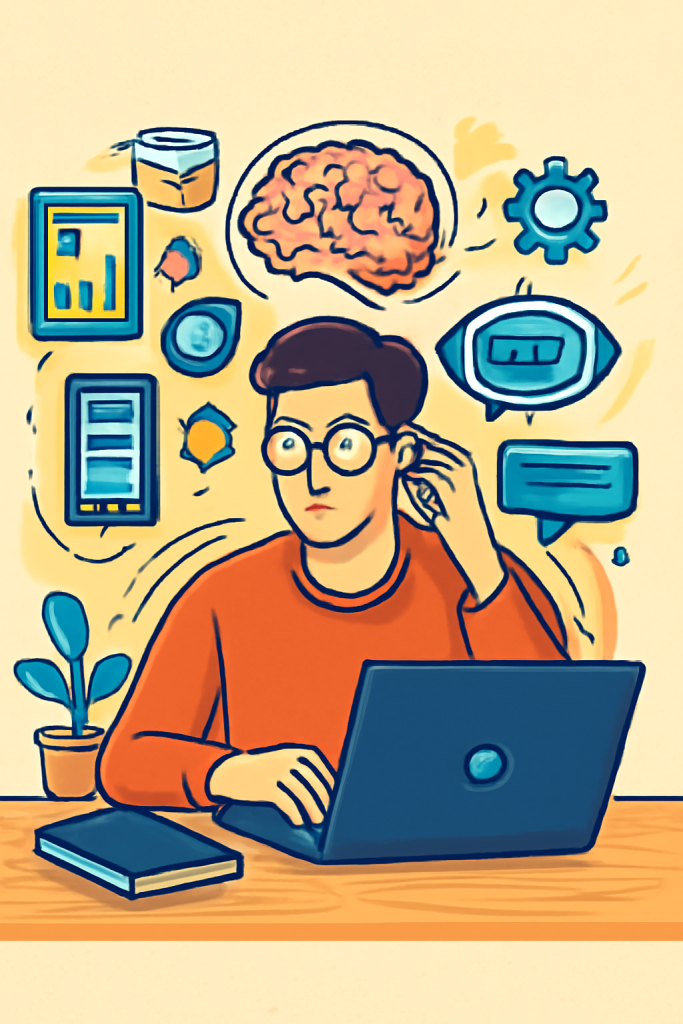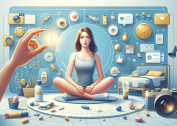The human brain is in a constant tug-of-war with technology. While digital tools can streamline our lives, they often overwhelm our minds, leading to stress, distraction, and burnout. But it doesn’t have to be this way. Learning how to make digital tools work with your brain—not against it—can transform technology from a mental burden into a cognitive ally.

The Neurological Toll of Digital Overload
The average adult now spends nearly 7 hours a day looking at screens, according to a recent Statista report. But constant screen exposure doesn’t come without a cost. Studies from the University of California, Irvine, show that workers switch tasks every 47 seconds when using digital devices, causing spikes in cortisol and reducing overall productivity (Mark et al. 2022).
This frequent switching taxes the brain’s prefrontal cortex, responsible for decision-making and attention. Instead of deep, focused thinking, the mind remains in a reactive loop, toggling between notifications, emails, and apps. It’s no wonder digital fatigue is becoming a global issue.
Additionally, dependency on AI and digital assistants contributes to what neuroscientists call “cognitive offloading.” This phenomenon happens when we rely on technology to remember or decide things for us, gradually weakening memory and analytical skills (Risko and Gilbert 2016).
Strategy #1: Prioritize Single-Tasking Over Multitasking
Multitasking might feel productive, but neuroscience says otherwise. Research published in the Journal of Experimental Psychology found that switching between tasks can reduce efficiency by up to 40% (American Psychological Association 2006). When we multitask, the brain splits attention, resulting in more errors and mental fatigue.
Solution: Use the Pomodoro Technique or Time Blocking to commit to focused sessions. Tools like Forest, Focusmate, and Notion help you concentrate on one task at a time while resisting the urge to context-switch.
Strategy #2: Reprogram Your Notifications for Focus
Digital distractions don’t just interrupt your workflow—they rewire your brain. The “variable reward” system created by social media notifications mimics gambling behavior, lighting up the brain’s dopamine pathways (Alter 2017). This can lead to compulsive checking and reduced attention span.
Solution: Audit your phone and computer notifications. Use “Do Not Disturb” during work hours. Apps like Freedom and Cold Turkey block time-wasting apps. Customize notification settings so only critical alerts get through.
Strategy #3: Use Technology That Supports Your Brain Health
Not all digital tools are harmful. Some are specifically designed to work with your brain rather than disrupt it.
Biofeedback and Mental Health Tech
For example, Prism by GrayMatters Health is a non-invasive digital therapy using EEG neurofeedback to treat depression and PTSD. This wearable reads brain patterns and uses visual cues to guide the brain into healthier activity states. Clinical trials showed significant symptom reduction without medication or traditional talk therapy (NY Post 2025).
AI Therapy Bots
AI mental health tools like Woebot and Wysa are making cognitive-behavioral therapy (CBT) accessible. These apps engage users in conversational check-ins, helping them build resilience and emotional regulation (News.com.au 2025). This is especially helpful for users experiencing stress or isolation, giving them immediate coping tools anytime, anywhere.
Strategy #4: Schedule Regular Digital Detoxes
Too much screen time can shrink your grey matter—literally. A study published in Nature linked excessive smartphone usage to reduced volume in areas of the brain responsible for emotional processing and attention (Horvath et al. 2020).
Solution: Plan regular screen-free periods throughout the day. Try a 24-hour digital Sabbath every weekend. Replace screen time with journaling, walking, or social interaction. Even 30 minutes of outdoor exposure can reset your cognitive functions and reduce stress hormones.
Strategy #5: Leverage AI and Digital Tools for Brain Augmentation
Artificial Intelligence is a double-edged sword. Used correctly, it enhances cognitive performance; used passively, it fosters dependency.
Use it to Challenge, Not Replace: Tools like ChatGPT, Perplexity, and Replika are powerful brainstorming partners. They can help refine your thinking, spark creativity, and simulate decision-making processes—provided you remain an active participant.
Automate Repetitive Tasks: Reserve your brainpower for critical thinking. Use digital tools like Zapier, IFTTT, or SaneBox to handle repetitive chores—emails, task reminders, and data entry—freeing up cognitive resources for innovation and insight.
Strategy #6: Reintroduce Analog Thinking
Ironically, the best way to improve your relationship with technology is to step away from it occasionally. Handwriting, sketching, and whiteboarding activate different neural circuits than typing, improving memory retention and creative thinking (Mueller and Oppenheimer 2014).
Try: Journaling your daily goals or summarizing meetings with pen and paper. Doodle mind maps instead of using slide decks. This physical interaction enhances encoding and comprehension—especially valuable in brainstorming or strategy sessions.
Strategy #7: Design Your Digital Environment for Flow
Flow is the optimal mental state where productivity and creativity peak. Distraction is the biggest enemy of flow.
Solution: Design a digital workspace that minimizes friction. Use minimalistic desktops, close unused tabs, and keep one window open per task. Combine productivity tools like Notion, Trello, or ClickUp into a unified system to reduce digital clutter.
Also, follow “one screen, one purpose.” Avoid using the same device for both entertainment and work to train your brain to associate specific screens with specific cognitive tasks.
Conclusion: Creating a Brain-First Tech Life
Technology isn’t inherently bad—it’s how we use it that matters. When aligned with how the human brain naturally works, digital tools can elevate focus, resilience, and creativity. By integrating digital hygiene practices, customizing tech to your mental rhythm, and using supportive innovations, you can finally make digital tools work with your brain—not against it.
References
- Mark, G., Iqbal, S., Czerwinski, M. (2022). The Cost of Interrupted Work: More Speed and Stress. University of California, Irvine.
- Alter, A. (2017). Irresistible: The Rise of Addictive Technology and the Business of Keeping Us Hooked. Penguin Press.
- Risko, E. F., & Gilbert, S. J. (2016). Cognitive Offloading. Trends in Cognitive Sciences, 20(9), 676–688.
- New York Post (2025). New technology treats depression without drugs, talk therapy. Available at: https://nypost.com/2025/05/15/health/new-technology-treats-depression-without-drugs-talk-therapy/
- News.com.au (2025). People are turning to AI apps like ChatGPT for therapy. Available at: https://www.news.com.au/technology/online/internet/people-are-turning-to-ai-apps-like-chat-gpt-for-therapy/news-story/22134d19107c0498ff63b28ace50fd03
- Horvath, J., et al. (2020). Smartphone usage and its impact on neuroplasticity. Nature Neuroscience.









